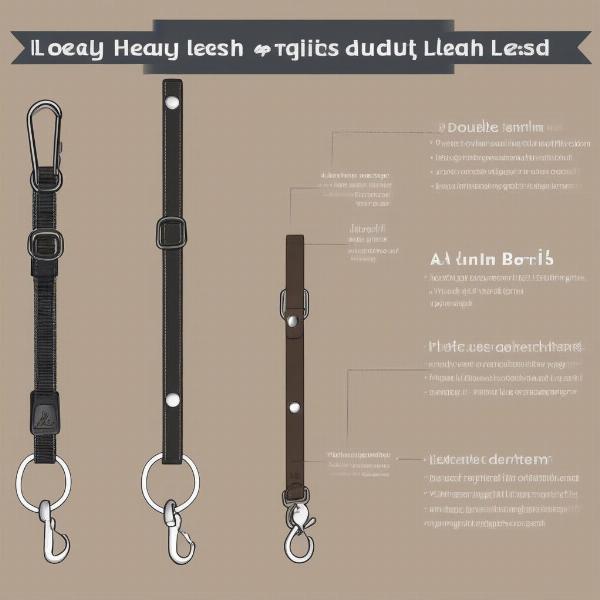Choosing the right lead for a strong dog is crucial for both your dog’s safety and your peace of mind. A strong lead isn’t just about preventing escapes; it’s about comfortable control, enjoyable walks, and building a positive relationship with your furry friend. This article will guide you through the different types of dog leads available, focusing on those best suited for dogs with a bit more muscle and energy. We’ll cover everything from materials and construction to special features and training tips, ensuring you can confidently choose the perfect lead for your powerful companion.
Understanding Your Strong Dog’s Needs
Before diving into the specifics of dog leads for strong dogs, it’s essential to assess your individual dog’s needs. Consider their breed, size, energy levels, and any behavioral tendencies. A highly energetic, large breed dog will require a different type of lead than a smaller, strong but calmer dog.
Do they tend to pull? If so, a no-pull harness or lead might be beneficial. Are they prone to chewing? Opt for a lead made from durable, chew-resistant material. Understanding your dog’s unique characteristics will help you narrow down the options and choose the most suitable lead.
Types of Dog Leads for Strong Dogs
Several types of dog leads cater specifically to stronger dogs. Let’s explore some of the most popular and effective options:
Heavy-Duty Leashes
These leads are typically made from thicker, more robust materials like nylon or leather, designed to withstand significant pulling force. Look for reinforced stitching and heavy-duty clips for added security.
Double-Handle Leads
Double-handle leads offer increased control, especially for dogs who tend to lunge or pull. The second handle, located closer to the dog’s collar, allows for more immediate control in challenging situations.
Chain Leads
While controversial, chain leads can be effective for training strong, pull-prone dogs. However, they should be used with caution and under the guidance of a professional trainer to avoid causing harm or discomfort to the dog.
 Strong Dog Leash Types
Strong Dog Leash Types
Materials and Construction: What to Look For
The material and construction of the lead are paramount when choosing one for a strong dog. Here are some key factors to consider:
- Material: Nylon is a popular choice due to its durability, weather resistance, and affordability. Leather offers a classic look and a comfortable grip but requires more care. Biothane is another excellent option known for its strength, waterproof nature, and easy cleaning.
- Stitching: Look for reinforced stitching, especially at stress points like the handle and clip attachment. Double or triple stitching is a good indicator of a well-made lead.
- Clips and Hardware: Choose leads with heavy-duty metal clips and hardware, ensuring they can withstand the force of a strong dog.
Training Tips for Strong Dogs on Leads
Choosing the right lead is just the first step. Proper training is essential for teaching your strong dog to walk politely on a leash. Here are a few tips:
- Positive Reinforcement: Reward your dog with treats and praise when they walk calmly beside you.
- Consistency: Use the same commands and techniques every time you walk your dog.
- Patience: It takes time and patience to train a strong dog to walk nicely on a lead. Don’t get discouraged if it doesn’t happen overnight.
Conclusion
Finding the right dog leads for strong dogs requires careful consideration of your dog’s individual needs and understanding the different types of leads available. Investing in a high-quality, durable lead and implementing consistent training techniques will ensure safe and enjoyable walks for both you and your powerful companion. Remember to prioritize your dog’s comfort and safety while working towards a positive and controlled walking experience.
FAQ
- What is the best lead for a dog that pulls? A double-handle lead or a no-pull harness can be beneficial for dogs that pull.
- What material is best for a strong dog lead? Nylon, leather, and biothane are all durable options.
- Are chain leads safe for dogs? Chain leads can be effective training tools, but they should be used with caution and under the guidance of a professional trainer.
- How do I train my strong dog to walk on a lead? Positive reinforcement, consistency, and patience are key to successful leash training.
- What are some other important considerations when choosing a strong dog lead? Consider the size and weight of your dog, the environment you typically walk in, and your dog’s chewing habits.
Related Articles
ILM Dog is your trusted resource for expert advice on dog care and training. We offer a comprehensive range of information on dog breeds, health, nutrition, and much more. Whether you’re a new dog owner or a seasoned pro, ILM Dog is here to support you every step of the way. For further assistance, feel free to contact us via email at [email protected] or by phone at +44 20-3965-8624. Learn more about our services and how we can help you and your furry friend thrive at ILM Dog.